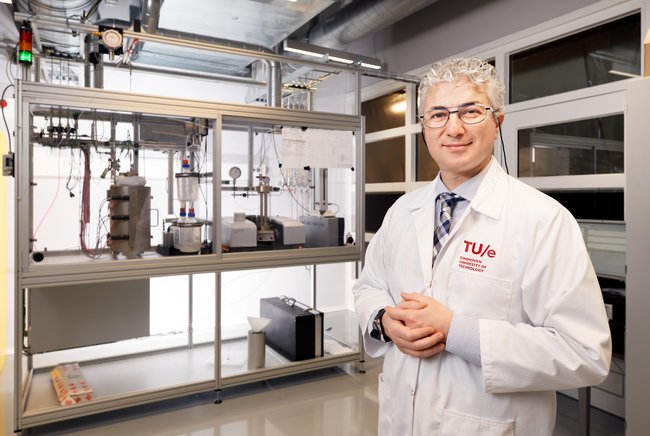Whether it is for the storage of hydrogen in ammonia or the production of bio-kerosene and biodiesel, smart chemical reactors are the way to go, according to chemical engineer Fausto Gallucci. By using membranes or plasma he is able to lower the needed temperatures and improve their efficiency. One of the biggest goals of his research is to scale up these reactors, taking them out of the lab and testing them in real-life industry settings.
Chemical reactors are used in the chemical industry to turn two or more raw materials into other substances. A separator does the opposite: it converts a specific solution into two or more substances. Fausto Gallucci is developing ‘smart’ reactor technology by combining the chemical reaction with a separation step in a single device, often using membranes: thin barriers that act as a sieve by being permeable to selected substances. This is much more efficient: you need less material since you only need a single reactor, and it conserves energy.
Membranes
The membranes Gallucci uses take the form of hollow, sealed tubes made of palladium, ceramics or carbon that are ‘hung up’ in a reactor vessel. These membrane tubes are selective as to the substances they let through so, for example, hydrogen (in the case of the palladium membrane) or oxygen (the ceramic tubes) is extracted from the reaction mixture. The oxygen molecules or hydrogen molecules react with the membrane, split into individual atoms that can permeate the material, and recombine inside the tube.
Removing the reaction product from the reaction mixture causes a shift in the chemical equilibrium, and so the reaction can take place at lower temperatures, Gallucci explains. ‘Thus, for example, you can extract hydrogen from methane at a temperature of 500 degrees instead of at a thousand degrees. This saves a huge amount of energy.’ Another example of such smart reactor technology is the use of plasma to activate methane at room temperature, with a similar energy gain. ‘Here on the campus we are collaborating on this with the Dutch Institute for Fundamental Research (DIFFER), which conducts fundamental research in the fields of fusion and solar fuels.’
Bio-kerosene
Although his chair gives priority to his work with membranes, they are not involved in one of the new projects. Here, Gallucci and his partners want to produce bio-kerosene (for aircraft) and biodiesel (for ships) from the glycerol that is a byproduct of making other biofuels. ‘This is already possible,’ Gallucci explains. ‘But we aim to do it with the minimum of CO2 emission; as energy efficiently as possible, in other words.’
Ammonia
The second new project involves developing ammonia as a sustainable storage medium for energy. Not unlike the students on Team FAST (who are carrying on their work as the company DENS, incidentally another of Gallucci’s collaborators in a past European project) who were working on hydrogen storage in the form of formic acid, the Italian and his colleagues want to store hydrogen in ammonia. ‘Using electrolysis powered by sustainably generated electricity we’ll release hydrogen from water. In a special reactor this hydrogen will be combined with nitrogen to produce ammonia.’ Then it’s just a matter of transporting the hydrogen in the form of ammonia, an easy-to-handle liquid, to the site where power is needed. ‘Once there, a membrane reactor, which we are also developing, can be used to release the hydrogen for use in a fuel cell.’




